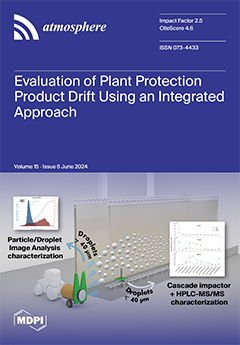UK air pollutant data collected over a 10-year period (2010–2019) from 46 sites with Urban Traffic, Urban Background, Suburban Background, Rural Background, and Urban Industrial environmental types were analysed to study the relationships between [NO] vs. [PM
2.5] and [O
3] vs. [PM
2.5] during the summer for each site type. These results were used to describe the consequence of recent PM
2.5 reductions on NO and O
3 concentrations at different site types across the UK. The strongest positive [NO] vs. [PM
2.5] correlation was observed for the Urban Traffic site type overall, but it displayed the weakest positive [O
3] vs. [PM
2.5] correlation. Analysis of individual Urban Traffic sites revealed an overall negative [O
3] vs. [PM
2.5] gradient at the London Marylebone Road (LMR) site. A sharp 35% PM
2.5 decrease occurred at LMR between 2011 and 2015 before annual mean concentrations plateaued. Further examination of annual correlations revealed negative [O
3] vs. [PM
2.5] gradients in each year directly proceeding the sharp 35% PM
2.5 decrease at LMR. NO
x fluctuations were minimal and accompanied by comparable volatile organic compound (VOC) decreases; thus, VOC-limited chemistry at LMR was deemed to not be the primary cause of O
3 increases. Instead, PM
2.5 reductions are suggested to be a more significant factor in causing O
3 increases, as suppression of O
3 production by PM
2.5 chemistry decreases with declining [PM
2.5]. The remaining two Urban Traffic sites in Birmingham did not display a negative [O
3] vs. [PM
2.5] correlation in the years studied. This was partly ascribed to the Birmingham measurement sites not being under the influence of the street canyon effect like LMR. Principal attribution was to the lower-average absolute initial PM
2.5 concentrations and absence of a significant (>26%) continuous mean PM
2.5 decline of greater than 2 years. This study therefore proposed a threshold initial PM
2.5 concentration (
t) above which O
3 suppression by PM
2.5 chemistry is sufficient to induce O
3 increases when average PM
2.5 concentrations significantly decline (by >26% across >2 years), where 17 μg m
−3 <
t < 26 μg m
−3. Extending this analysis to additional cities across the UK as sufficient data become available would allow refinement of the proposed threshold and improved understanding of the influence from the street canyon effect. These results inform future air pollution policies, in the UK and across the globe, in which further joint reductions of PM
2.5 and O
3 are crucial to achieve maximum benefits to human health.
Full article





